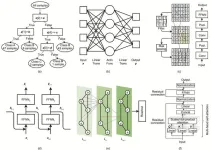(Press-News.org) Opposites don’t actually attract.
That’s the takeaway from a sweeping CU Boulder analysis of more than 130 traits and including millions of couples over more than a century.
“Our findings demonstrate that birds of a feather are indeed more likely to flock together,” said first author Tanya Horwitz, a doctoral candidate in the Department of Psychology and Neuroscience and the Institute for Behavioral Genetics (IBG).
The study, published Aug. 31 in the journal Nature Human Behaviour, confirms what individual studies have hinted at for decades, defying the age-old adage that “opposites attract.”
It found that for between 82% and 89% of traits analyzed—ranging from political leanings to age of first intercourse to substance use habits—partners were more likely than not to be similar.
For only 3% of traits, and only in one part of their analysis, did individuals tend to partner with those who were different than them.
Aside from shedding light on unseen forces that may shape human relationships, the research has important implications for the field of genetic research.
“A lot of models in genetics assume that human mating is random. This study shows this assumption is probably wrong,” said senior author and IBG Director Matt Keller, noting that what is known as “assortative mating”—when individuals with similar traits couple up—can skew findings of genetic studies.
Looking back more than a century
For the new paper, the authors conducted both a review, or meta-analysis, of previous research and their own original data analysis.
For the meta-analysis, they looked at 22 traits across 199 studies including millions of male-female co-parents, engaged pairs, married pairs or cohabitating pairs. The oldest study was conducted in 1903.
In addition, they used a dataset called the UK Biobank to study 133 traits, including many that are seldom studied, across almost 80,000 opposite-sex pairs in the United Kingdom.
Same sex couples were not included in the research. Because the patterns there may differ significantly, the authors are now exploring those separately.
Across both analyses, traits like political and religious attitudes, level of education, and certain measures of IQ showed particularly high correlations. For instance, on a scale in which zero means there is no correlation and 1 means couples always share the trait, the correlation for political values was .58.
Traits around substance use also showed high correlations, with heavy smokers, heavy drinkers and teetotalers tending strongly to partner up with those with similar habits.
Meanwhile, traits like height and weight, medical conditions and personality traits showed far lower but still positive correlations. For instance, the correlation for neurotocism was .11.
For some traits, like extroversion, there was not much of a correlation at all.
“People have all these theories that extroverts like introverts or extroverts like other extroverts, but the fact of the matter is that it’s about like flipping a coin: Extroverts are similarly likely to end up with extroverts as with introverts,” said Horwitz.
Rarely, opposites may attract
In the meta-analysis, the researchers found “no compelling evidence” on any trait that opposites attract. In the UK Biobank sample, they did find a handful of traits in which there seemed to be a negative correlation, albeit small.
Those included: chronotype (whether someone is a “morning lark” or “night owl”), tendency to worry and hearing difficulty.
More research must be done to unpack those findings, they said.
The trait for which couples were most likely to be similar was, not surprisingly, birth year.
But even seldom-studied traits, like how many sexual partners a person had had or whether they had been breastfed as a child, showed some correlation.
“These findings suggest that even in situations where we feel like we have a choice about our relationships, there may be mechanisms happening behind the scenes of which we aren't fully aware,” said Horwitz.
Next-generation implications
The authors note that couples share traits for a variety of reasons: Some grow up in the same area. Some are attracted to people who are similar to them. Some grow more similar the longer they are together.
Depending on the cause, there could be downstream consequences.
For example, Horwitz explains, if short people are more likely to produce offspring with short people and tall people with tall people, there could be more people at the height extremes in the next generation. The same goes for psychiatric, medical or other traits.
There could also be social implications.
For instance, some small previous studies have suggested that people in the U.S. are growing more likely to couple up with people with similar educational backgrounds—a trend that, some theorize, could widen the socioeconomic divide.
Notably, the new study also showed that the strength of correlations for traits differed across populations. They likely also change over time, the authors suspect.
The researchers caution that the correlations they found were fairly modest and should not be overstated or misused to promote an agenda (Horwitz points out that assortative mating research was, tragically, co-opted by the eugenics movement).
They do hope the study will spark more research across disciplines, from economics to sociology to anthropology and psychology.
“We’re hoping people can use this data to do their own analyses and learn more about how and why people end up in the relationships they do,” she said.
END
Study confirms it: Opposites don't actually attract
A sweeping new analysis including data from millions of couples shows that birds of a feather flock together
2023-09-05
ELSE PRESS RELEASES FROM THIS DATE:
Poor water quality disproportionately affects socially vulnerable communities
2023-09-05
A new study published in IOP Publishing’s journal Environmental Research Letters examines the links between drinking water quality violations and social vulnerability in the United States, revealing that these violations disproportionately affect the most vulnerable communities. Approximately 70% of the population affected ranked in the highest social vulnerability category, with many different social parameters, beyond income, linked to different drinking water quality violations.
The study, led by researchers from the Jackson School of Geosciences, University of Texas in Austin, used new water quality data ...
Impact of COVID-19 pandemic on emergency department use in British Columbia
2023-09-05
A new study showing the impact of the COVID-19 pandemic and mitigation strategies used to manage the virus on emergency department (ED) visits in British Columbia can help with future planning. The study is published in CMAJ (Canadian Medical Association Journal) https://www.cmaj.ca/lookup/doi/10.1503/cmaj.221516.
"Evaluation of the effects of the pandemic and associated measures can provide a historical account and inform health care service planning for both postpandemic recovery and mitigation of potential consequences ...
THE LANCET PLANETARY HEALTH: Experts warn 'green growth' in high income countries is not happening, call for 'post-growth' climate policies to meet Paris targets
2023-09-05
Peer-reviewed / Empirical study
New study challenges political claims that some high-income countries have achieved “green growth”– revealing that under current growth-oriented strategies, emission reductions in these nations fall drastically short of meeting the climate goals and fairness requirements of the Paris Agreement.
If current trends continue, even the 11 high-income countries that have "decoupled" carbon emissions from GDP growth would on average take over 200 years to get their emissions close to zero, and would emit more than 27-times their fair share of the “global carbon budget” ...
Pharmacy discount card programs like Amazon Prime and GoodRx gold could save patients millions of dollars in out-of-pocket costs for commonly prescribed generic medications
2023-09-04
Embargoed for release until 5:00 p.m. ET on Monday 04 September 2023
Annals of Internal Medicine Tip Sheet
@Annalsofim
Below please find summaries of new articles that will be published in the next issue of Annals of Internal Medicine. The summaries are not intended to substitute for the full articles as a source of information. This information is under strict embargo and by taking it into possession, media representatives are committing to the terms of the embargo not only on their own behalf, but also on behalf of the organization they represent.
----------------------------
1. New ACP paper addresses ethical issues in determining death; recommends clarification to the Uniform Determination ...
Farms that create habitat key to food security and biodiversity
2023-09-04
It seems intuitive that forests would provide better habitat for forest-dwelling wildlife than farms. Yet, in one of the longest-running studies of tropical wildlife populations in the world, Stanford researchers found that over 18 years, smaller farms with varying crop types – interspersed with patches or ribbons of forest – sustain many forest-dependent bird populations in Costa Rica, even as populations decline in forests.
In a paper published Sept. 4 in the Proceedings of the National Academy of Sciences, Nicholas Hendershot and colleagues ...
The art of wandering in vertebrates: new mapping of neurons involved in locomotion
2023-09-04
For those fortunate enough to walk normally, wandering is such an expected behavior that we hardly consider that it involves complex, partly involuntary processes. “Animals move to explore their environment in search of food, interaction with others, or simply out of curiosity. But the perception of danger or a painful stimulus can also activate an automatic flight reflex”, Martin Carbo-Tano, a post-doctoral fellow at Paris Brain Institute, explains. In both cases, movement initiation relies on the activation of so-called reticulospinal control neurons, which form an intertwined network in ...
Most species are rare. But not very rare
2023-09-04
Halle/Saale, Fort Lauderdale. More than 100 years of observations in nature have revealed a universal pattern of species abundances: Most species are rare but not very rare, and only a few species are very common. These so-called global species abundance distributions have become fully unveiled for some well-monitored species groups, such as birds. For other species groups, such as insects, however, the veil remains partially unlifted. These are the findings of an international team of researchers led by the German Centre for Integrative Biodiversity Research (iDiv), the Martin Luther University Halle-Wittenberg ...
Extreme El Niño weather saw South America’s forest carbon sink switch off
2023-09-04
Extreme El Niño weather saw South America’s forest carbon sink switch off
Hot and dry conditions resulted in increased tree death
Evidence that most forest areas withstand periods of severe drought
Greatest impact in forests with drier climates
Tropical forests in South America lose their ability to absorb carbon from the atmosphere when conditions become exceptionally hot and dry, according to new research.
For a long time, tropical forests have acted as a carbon sink, taking more ...
Blowing snow contributes to Arctic warming
2023-09-04
When it comes to global warming trends, the Arctic is a troubling outlier. The Arctic warms nearly four times faster than the global average, and aerosols play an important role in that warming. Scientists have long known that pollutants from other regions can accumulate in the Arctic atmosphere where they alter atmospheric chemistry, absorb sunlight, and affect local weather patterns, leading to localized warming that melts ice and snow. Sea salt particles dominate aerosol mass concentration, but their production mechanisms and impact on Arctic climate have remained unclear.
Atmospheric scientists led by Jian Wang, director of the Center for Aerosol ...
Innovative solutions for chemical challenges: Harnessing the potential of machine learning
2023-09-04
In a review published in Engineering, scientists explore the burgeoning field of machine learning (ML) and its applications in chemistry. Titled “Machine Learning for Chemistry: Basics and Applications,” this comprehensive review aims to bridge the gap between chemists and modern ML algorithms, providing insights into the potential of ML in revolutionizing chemical research.
Over the past decade, ML and artificial intelligence (AI) have made remarkable strides, bringing us closer to the realization of intelligent machines. The advent of deep learning methods and enhanced data storage capabilities has played a pivotal role in this progress. ML has already demonstrated success ...
LAST 30 PRESS RELEASES:
On-demand upgraded recycling of polyethylene and construction of sustainable multifunctional materials based on the "LEGO" strategy
New "Stomata in-sight" system allows scientists to watch plants breathe in real-time
Anorexia nervosa may result in long-term skeletal muscle impairment
Narrative-based performance reviews deemed fairest by employees
New insights reveal how advanced oxidation can tackle emerging water pollutants
New review shows how biomass can deliver low-carbon gaseous fuels at scale
Climate change is quietly rewriting the world’s nitrogen cycle, with high stakes for food and the environment
Study finds SGLT-2 inhibitors linked to lower risk of diabetic foot nerve damage
Microbes may hold the key to brain evolution
Study examines how the last two respiratory pandemics rapidly spread through cities
Gender stereotypes reflect the division of labor between women and men across nations
Orthopedics can play critical role in identifying intimate partner violence
Worms as particle sweepers
Second spider-parasitic mite described in Brazil
January 2026 issues of APA journals feature new research on autism, pediatric anxiety, psychedelic therapy, suicide prevention and more
Private equity acquired more than 500 autism centers over the past decade, new study shows
New cervical cancer screening guidelines from the US Department of Health and Human Services
Estimated burden of COVID-19 illnesses, medical visits, hospitalizations, and deaths in the US from October 2022 to September 2024
Smartphone use during school hours by US youth
Food insecurity and adverse social conditions tied to increased risk of long COVID in children
Earliest, hottest galaxy cluster gas on record could change our cosmological models
Greenland’s Prudhoe Dome ice cap was completely gone only 7,000 years ago, first GreenDrill study finds
Scientific validity of blue zones longevity research confirmed
Injectable breast ‘implant’ offers alternative to traditional surgeries
Neuroscientists devise formulas to measure multilingualism
New prostate cancer trial seeks to reduce toxicity without sacrificing efficacy
Geometry shapes life
A CRISPR screen reveals many previously unrecognized genes required for brain development and a new neurodevelopmental disorder
Hot flush treatment has anti-breast cancer activity, study finds
Securing AI systems against growing cybersecurity threats
[Press-News.org] Study confirms it: Opposites don't actually attractA sweeping new analysis including data from millions of couples shows that birds of a feather flock together




